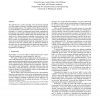Free Online Productivity Tools
i2Speak
i2Symbol
i2OCR
iTex2Img
iWeb2Print
iWeb2Shot
i2Type
iPdf2Split
iPdf2Merge
i2Bopomofo
i2Arabic
i2Style
i2Image
i2PDF
iLatex2Rtf
Sci2ools
SIGCOMM
1999
ACM
1999
ACM
The End-to-End Effects of Internet Path Selection
The path taken by a packet traveling across the Internet depends on a large number of factors, including routing protocols and pernetwork routing policies. The impact of these factors on the endto-end performance experienced by users is poorly understood. In this paper, we conduct a measurement-based study comparing the performance seen using the “default” path taken in the Internet with the potential performance available using some alternate path. Our study uses five distinct datasets containing measurements of “path quality”, such as round-trip time, loss rate, and bandwidth, taken between pairs of geographically diverse Internet hosts. We construct the set of potential alternate paths by composing these measurements to form new synthetic paths. We find that in 30-80% of the cases, there is an alternate path with significantly superior quality. We argue that the overall result is robust and we explore two hypotheses for explaining it.
Alternate Path | Communications | Pernetwork Routing Policies | Potential Alternate Paths | SIGCOMM 1999 |
| Added | 03 Aug 2010 |
| Updated | 03 Aug 2010 |
| Type | Conference |
| Year | 1999 |
| Where | SIGCOMM |
| Authors | Stefan Savage, Andy Collins, Eric Hoffman, John Snell, Thomas E. Anderson |
Comments (0)

